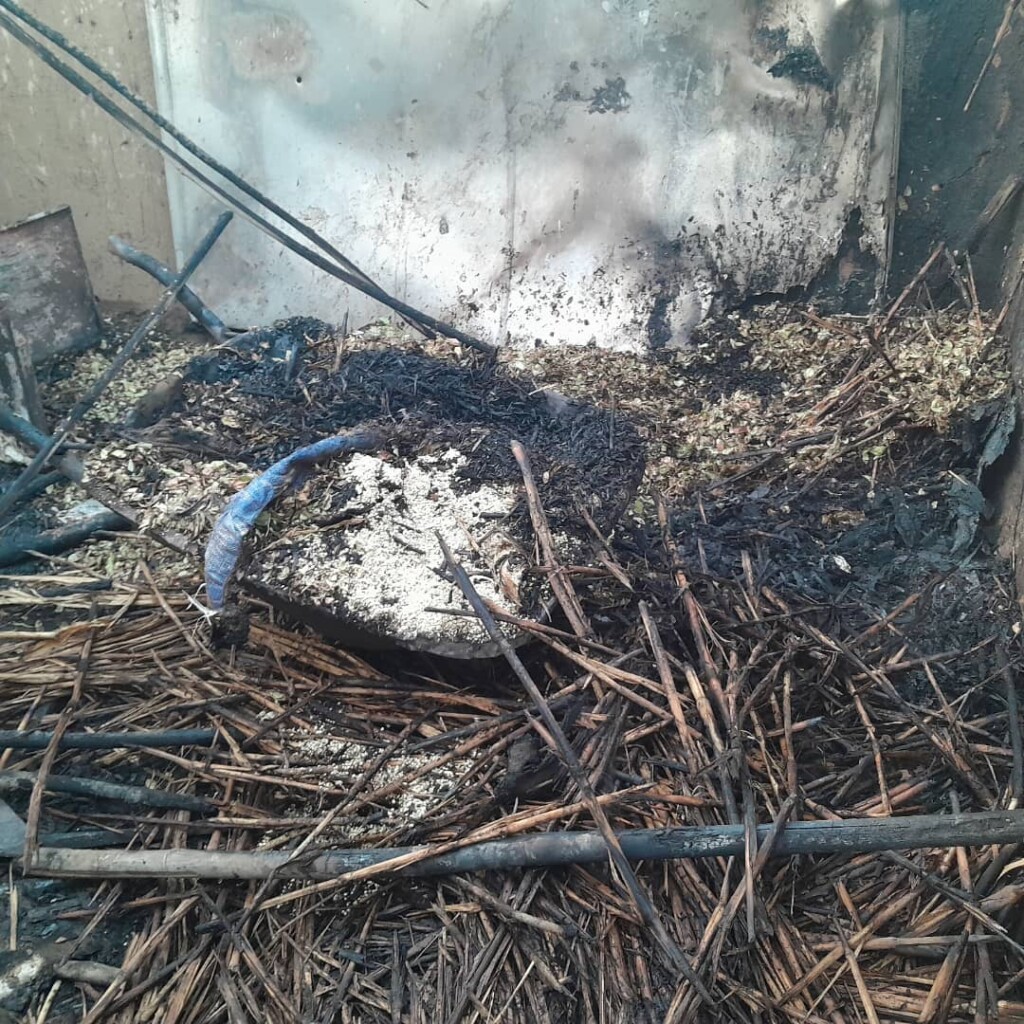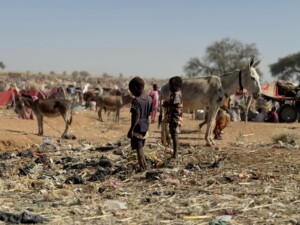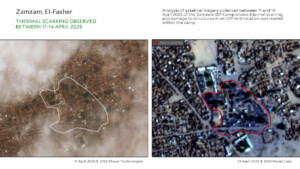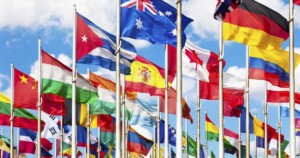Sudan war: situation in North Darfur Abu Shouk camp ‘intolerable’

Results of the bombing of Abu Shouk camp for displaced people near El Fasher, capital of North Darfur on March 7 (File photo: RD)
Dozens of people were killed, and many others were wounded by shelling in the Abu Shouk camp for the displaced north of El Fasher, capital of North Darfur, in the past two weeks. As the fighting between the Rapid Support Forces (RSF) that is besieging the city and the Sudanese Armed Forces (SAF) continues and food has become very scarce, many more camp residents are fleeing their shelters towards the south.
“More than 50 people died and at least 74 others were wounded by missiles in 14 days,” a member of the Abu Shouk Emergency Room told Radio Dabanga on Friday. He attributed the ongoing fierce fighting near the camp to its geographical location: “Abu Shouk lies in the middle of the battle field.”
The activist, who preferred to remain anonymous, described the situation in Abu Shouk camp as extremely difficult and miserable. “No one dares to leave the camp in the mornings because the artillery shelling usually starts at dawn and continues until noon. Shells are falling everywhere, on the streets, at houses, shops, and market stalls,” he said.
“The fighting has caused extensive damage to the camp. The displaced live day by day. If they cannot not go to the market, they don’t have a meal for the day. But many don’t have work anymore, so most of the camp residents have become beggars.”
The emergency room member further reported that the continuous shelling has led to the destruction of several health centres, including the one of the International Rescue Committee (IRC) centre, “which was shelled three times”, in addition to the the therapeutic feeding centre in the camp.
“We, of the camp’s emergency room, are now unable to do anything because of the great risks caused by the artillery shelling.”
He added that large numbers of Abu Shouk residents fled to the Zamzam camp, south of El Fasher, and to areas under control of the Sudan Liberation Movement of Abdelwahid El Nur.
“However, there are also families that are forced to remain in the camp because they cannot afford to move anywhere else, while others see no difference between their departure and their stay in the camp.”
Famine
The situation in Zamzam camp, the largest one in Darfur, is not much better. Médecins Sans Frontières (MSF) reported already in early February that “all emergency thresholds for malnutrition have been reached” in Zamzam camp, with about one child dying every two hours.
Prominent Sudan researcher and analyst Eric Reeves who has set up an aid project in Zamzam, stated on Friday that “There seems to be little chance that international humanitarian organizations providing food aid will arrive anytime soon: the brutal Rapid Support Forces have laid siege to El Fasher, creating intolerable insecurity”.
The International Crisis Group (ICG) reported in a new briefing on Monday that “many thousands are on the brink of famine.
“Expanded hostilities in El Fasher would bring greater misery,” the ICG warned.
“The El Fasher area hosts over a million civilians, many of whom are already displaced by the conflict and teetering on the edge of survival. Even a prolonged siege threatens their lives, but an escalating battle for the city could lead to mass slaughter and other atrocities.”
According to the influential crises watchdog, the United Nations and the USA “should try mediating a de-escalation and local truce. In conjunction, influential Arab and African leaders should press the sides to stand down.
“All should insist on safe corridors for fleeing civilians, immediate aid access to Darfur’s starving people and a return to national talks.”
On June 13, the UN Security Council adopted a British-drafted resolution on Thursday, demanding that the RSF cease its blockade on El Fasher.
El Fasher
The RSF is in control of four of the five Darfur states. In October last year, the paramilitaries occupied Nyala and Zalingei, and El Geneina and Ed Daein a month later. They have also seized control of parts of North Darfur.
El Fasher is an important strategic city, hosting the government of the Darfur region resides and the Darfur Joint Force, made up of former rebel combatants of the Sudan Liberation Movement faction led by Minni Minawi, governor of the Darfur region, other breakaway SLM groups and factions of the Justice and Equality Movement (JEM).
SAF-RSF fighting already occurred in the North Darfur capital since the start of the war in mid-April last year. In end April, the SAF gained control over the city, prompting RSF’s retreat to the camps for the displaced northeast of the city and areas further north. The then North Darfur Governor Nimir Abdelrahman, a former rebel leader, managed, together with native administration leaders, police officers, and civil society activists, to make the warring parties in the region agree on a ceasefire and extend it more than once.
Following this period, the North Darfur capital witnessed fighting again. The RSF seized control of the eastern parts of the city, while the SAF fortified their hold over the western parts. Fighting continued on and off in the following months.
Security conditions began to deteriorate rapidly in El Fasher in late October as violent clashes erupted again between the two parties and led to mass displacement. An estimated 85 per cent of the population of the city’s northern neighbourhoods fled their homes.
Renewed SAF-RSF battles erupted in February, with many fearing a “catastrophic bloodbath” in the area. The RSF taking full control of the city would reportedly also ignite strife between the Arab tribes supporting the RSF and the Zaghawa tribe, from which most North Darfur rebel fighters hail.











 and then
and then